
current / archive / issues / faq / RSS feed / twitter /
Blog Archive: September 2018
The Prisoner, The Power, And Dr. Doom!This story is an early example of the problems that come up when a wandering character like Doom gets tied down to his own series. Previously he's been free to pop up wherever a creative team want to use him, but now he has his own series there are continuity questions to consider. When last we saw him he was in a Mexican stand-off with The Faceless One and The Doomsman in Latveria, but this issue calls for him to be elsewhere. The story deals with this problem by... completely ignoring it.
The story begins with Thor giving himself a brief recap of his previous adventure, where Loki impersonated him to stir up a load of trouble. His thoughts are interrupted however by a right old racket on the streets below, which turns out to be an argument over a demonstration outside the Latverian Embassy.
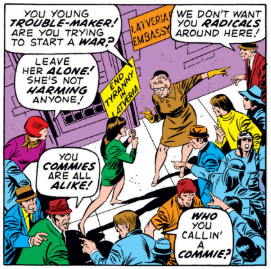 I do like the way Stan Lee is trying to engage with modern politics here, using the Latverian Embassy as a metaphor for all the other embassies young people were protesting outside, and about, at this time, while being sure to have all viewpoints expressed, with John Buscema illustrating a (still dynamically drawn) old lady worried about this all causing a war. It's also another example of Lee falling in love with his own idea of Doom being unique among supervillains in that his power is partly derived from diplomatic immunity. To be fair, it's a great idea, but it's noticeable that he returns to it every time he writes Doom now.
I do like the way Stan Lee is trying to engage with modern politics here, using the Latverian Embassy as a metaphor for all the other embassies young people were protesting outside, and about, at this time, while being sure to have all viewpoints expressed, with John Buscema illustrating a (still dynamically drawn) old lady worried about this all causing a war. It's also another example of Lee falling in love with his own idea of Doom being unique among supervillains in that his power is partly derived from diplomatic immunity. To be fair, it's a great idea, but it's noticeable that he returns to it every time he writes Doom now.
Thor changes into his human identity of Don Blake to investigate, but quickly gets caught up in things as the demonstration turns into a riot, forcing him to transform into Thor again to scare people away and escort an injured girl - the same girl who instigated the demonstration - to safety. When the girl awakes she finds Don Blake watching over her again, who asks her what she was protesting for.
This seems a bit odd to me - surely you don't need a personal connection to protest against an authoritarian regime - but it turns out she has a link anyway, and proceeds to explain how her father was kidnapped by Doom years ago, and how she was kept as a hostage to ensure that he complied with Doom's wishes. During this flashback we once again see Doom as the sauvely relaxed liar who believes all of his own propaganda - very much in line with Lee's own recent characterisation, but different from the version seen in the contemporary story in Astonishing Tales.
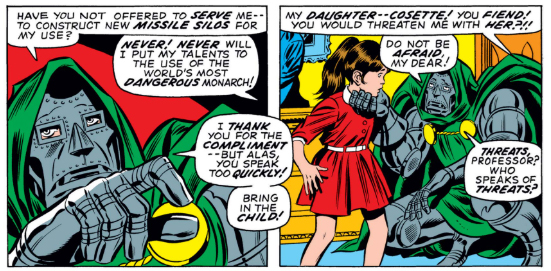 The girl, Cosette, escaped recently with the aid of the underground, who are shown here in an unambiguously heroic light, again differing from the story running simultaneously in Astonishing Tales.
The girl, Cosette, escaped recently with the aid of the underground, who are shown here in an unambiguously heroic light, again differing from the story running simultaneously in Astonishing Tales.
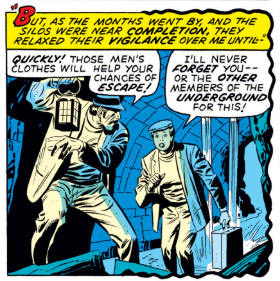 Don Blake decides to help, and turns back into Thor only to be interrupted by a message from Odin, who calls him back to Asgard fro a brief interlude involving the ongoing sub-plot of The World Beyond. That doesn't concern us here, suffice to say it's all very mysterious and then Thor heads back to Midgard to undertake a cunning scheme of his own.
Don Blake decides to help, and turns back into Thor only to be interrupted by a message from Odin, who calls him back to Asgard fro a brief interlude involving the ongoing sub-plot of The World Beyond. That doesn't concern us here, suffice to say it's all very mysterious and then Thor heads back to Midgard to undertake a cunning scheme of his own.
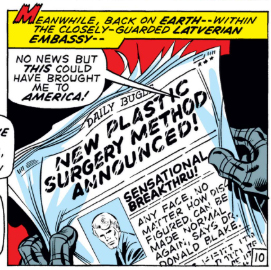 He's planted a Fake News story in the Daily Bugle, claiming he can cure any facial injury, no matter how severe. Thor thinks, correctly, that this will bring Don Blake to the notice of Doctor Doom, but doesn't seem particularly bothered about all the other victims of facial injury who, surely, will see this and be filled with false hope.
He's planted a Fake News story in the Daily Bugle, claiming he can cure any facial injury, no matter how severe. Thor thinks, correctly, that this will bring Don Blake to the notice of Doctor Doom, but doesn't seem particularly bothered about all the other victims of facial injury who, surely, will see this and be filled with false hope.
Over at the embassy Doom reads the piece and we get a re-run of two recurring Doom tropes - ripping up a newspaper in rage, and standing disconsolately in front of a mirror.
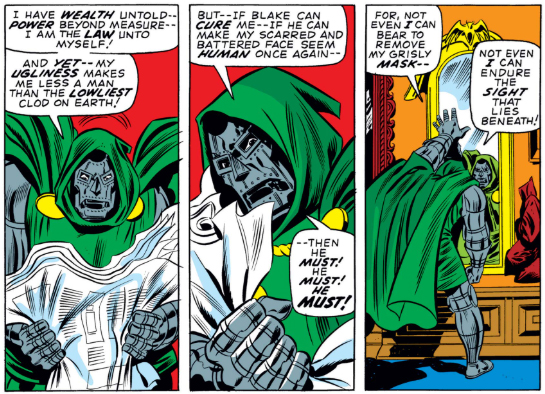 As mentioned, this is all a bit difficult for the Marvel Universe's ongoing continuity - we know that Doom is currently fighting against a revolution in Latveria, so what's he doing in America lounging around in the embassy? When most of the titles were written by Stan Lee this was not an issue (except when he forgotten what he'd written previously, of course) and the Marvel Universe was able to maintain coherence, but as it expands, and other writers want to use the same characters, this is becoming a problem which, in the coming decade, would require solutions.
As mentioned, this is all a bit difficult for the Marvel Universe's ongoing continuity - we know that Doom is currently fighting against a revolution in Latveria, so what's he doing in America lounging around in the embassy? When most of the titles were written by Stan Lee this was not an issue (except when he forgotten what he'd written previously, of course) and the Marvel Universe was able to maintain coherence, but as it expands, and other writers want to use the same characters, this is becoming a problem which, in the coming decade, would require solutions.
Stan Lee regularly places Doctor Doom in the Latverian Embassy, which not only reinforces his position as a head of state with vaguely defined diplomatic immunity, but also allows him to interact with the rest of the superhero/villain community. Here he's able to pop out in his limousine, find Don Blake wandering the streets, and kidnap him using a Molecule Displacer. He's then driven out into the woods, where he uncovers a secret helicopter/missile ship, which he uses to fly a sleeping Don Blake to a noticeably peaceful and intact version of Latveria.
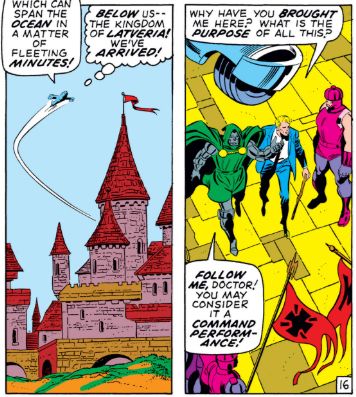 Doom takes Blake into a private room and prepares him to see "a sight that no other human eyes save mine have ever yet beheld", which isn't quite true, but anyway. He takes his mask off and Don Blake reacts with spectacular unprofessionalism.
Doom takes Blake into a private room and prepares him to see "a sight that no other human eyes save mine have ever yet beheld", which isn't quite true, but anyway. He takes his mask off and Don Blake reacts with spectacular unprofessionalism.
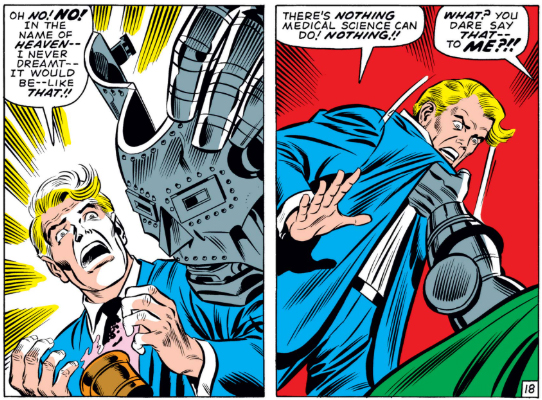 I think Doom has every right to report him to the American Medical Association. It's not exactly tactful, is it? Blake is, quite reasonably, chucked in a dungeon with his walking stick placed just out of reach. He needs this stick to transform into Thor and... quickly manages to get hold of it and transform, in a brief sequence that is not quite as exciting as it was maybe meant to be. Thor bursts out of the dungeon and into the cliffhanger for the next issue - Doom launches a missile to bring down a "foreign object" spied overhead, leaving Thor with a "deadly dilemma".
I think Doom has every right to report him to the American Medical Association. It's not exactly tactful, is it? Blake is, quite reasonably, chucked in a dungeon with his walking stick placed just out of reach. He needs this stick to transform into Thor and... quickly manages to get hold of it and transform, in a brief sequence that is not quite as exciting as it was maybe meant to be. Thor bursts out of the dungeon and into the cliffhanger for the next issue - Doom launches a missile to bring down a "foreign object" spied overhead, leaving Thor with a "deadly dilemma".
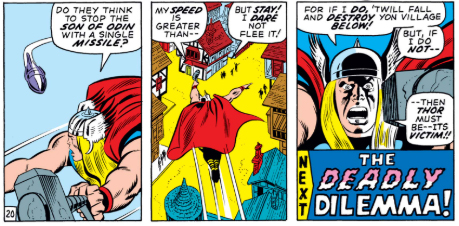 We'll find out what happens soon (SPOILERS: Thor makes it out OK), but before then we're back to Latveria to see what's going on with The Doomsman!
We'll find out what happens soon (SPOILERS: Thor makes it out OK), but before then we're back to Latveria to see what's going on with The Doomsman!
posted 28/9/2018 by MJ Hibbett
(click here for permanent link)
(0) comments
Revolution!
The second issue of Doom's own series begins with a masthead declaring him "Doctor Doom, Master Of Menace!" It's an odd way of celebrating, well, villainy, and is part of the ongoing difficulty these stories have in portraying Doom as the hero of the story whilst he carried on behaving like the Mad Scientist/Evil dictator he has always been. Modern versions of this sort of story, like Brian Bendis's "Infamous Iron Man" series, tend to try to make Doom more sympathetic by giving him regrets, or at least better reasons for his villainy, and although that does happen later in this series, there's still a lot of menacing, mad science, and dictating.
Inside Castle Doom we find Ramona and Rudolfo imprisoned after their attempted revolution in the last issue. Rudolfo speaks ominously about "The Faceless One", leaving Ramona (and us) to wonder what he's on about, as this person has never been mentioned before. "There is much that you do no know, Ramona!" he replies, before leaping up the wall and ripping open the bars.
His escape is short-lived, as he bumps into Doctor Doom who immediately works out what's going on - Rudolfo is, of course, a robot! I must say, I do like the way that Roy Thomas sticks to the idea that Doom is a genius. rarely fooled by events that are commonalities in a superhero universe such as robot doubles or, as with his uncovering of Ramona's true identity last time, human lookalikes.
There's still a big surprise for Doom though, when he's told that this is not just any robot double, but one he built himself as a stand-in for Rudolfo at Doom's own coronation.
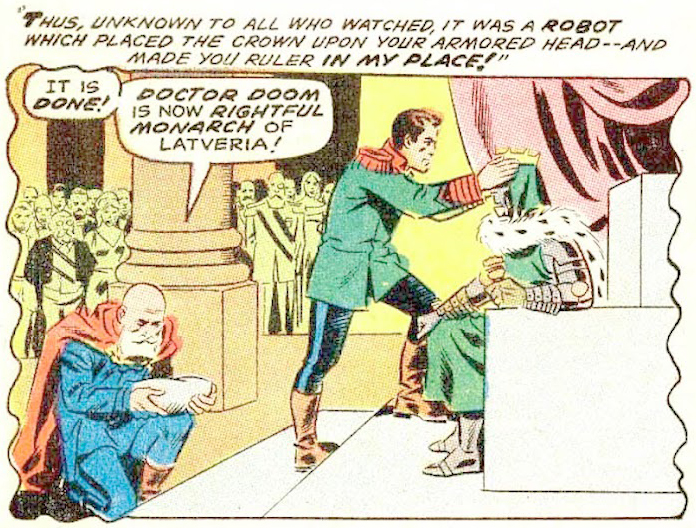 This is not only a neat way of explaining where the revolution obtained a robot, but also fills in a missing piece of Doom's origin story. Filling in the gaps between previous stories is something that Roy Thomas would go on to do many times in the future, and here it feels very satisfying to get a glimpse of a previously unseen episode in Doom's past as part of the ongoing story.
This is not only a neat way of explaining where the revolution obtained a robot, but also fills in a missing piece of Doom's origin story. Filling in the gaps between previous stories is something that Roy Thomas would go on to do many times in the future, and here it feels very satisfying to get a glimpse of a previously unseen episode in Doom's past as part of the ongoing story.
Miles away the real Rudolfo is watching the destruction of his robot double. His viewing is interrupted by the arrival of the previously mentioned Faceless One, who not only reminds Rudolfo who's boss ("I call you what I will, because you cannot regain your petty throne without my secret help!") but also tells him what happened to the Doomsman, who escaped last issue. This android with Doom's brain patterns has fought his way across country and into the Soviet Union, bashing up tanks and striding through explosions. "We must have him as our ally!" says The Faceless One, so the pair of them hop into his Spheroid space shop and zoom off to find him.
While that's going on Doom is hanging around with Ramona, allowing her the chance to kill him as a test, which she fails ... or passes, depending on how you look at it. She's unable to kill him anyway, reassuring him that it is safe to allow her to wander the castle. "It is beneath me to imprison a woman" he says, a load of nonsense which, surely, is his way of hiding the fact that he just likes having her around?
He tears himself away from his passive aggressive stalking to return to his favourite place - the TV lounge - where he watches the resistance attacking yet more of his robots.
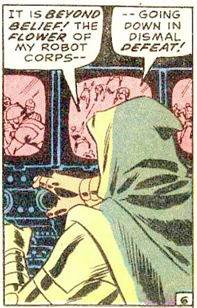 It's noticeable that the narrative text refers to the resistance in phrases like "skulking rebels" during this story, not "noble revolutionaries" or "resistance fighters" as they might be termed elsewhere. Doom is a terrible person but, it seems, nobody else is much better.
It's noticeable that the narrative text refers to the resistance in phrases like "skulking rebels" during this story, not "noble revolutionaries" or "resistance fighters" as they might be termed elsewhere. Doom is a terrible person but, it seems, nobody else is much better.
The rebels attack and Doom goes off to fight them, leaving the castle apparently unguarded, so that The Faceless One and the newly recruited Doomsman can easily sneak in, kill the remaining guards, and kidnap Ramona. Doom flies back and easily battles his way through the rebels, merrily gunning them down in a manner which almost, but not quite, seems heroic.
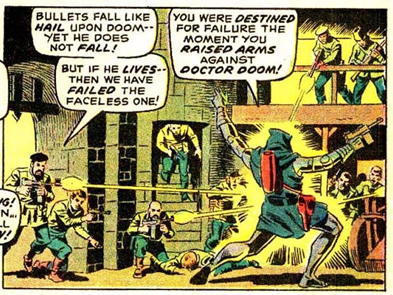 In a way this is all feels very modern, reminiscent of something like "Game Of Thrones" where we find ourselves cheering on morally "complex" characters doing dreadful things to other baddies in order to get their way. The story ends with Doom and The Faceless One finding themselves equals in battle, only to be disturbed by the sudden entrance of the Doomsman, who ends the story stood between the two evil characters, with nobody sure what will happen next.
In a way this is all feels very modern, reminiscent of something like "Game Of Thrones" where we find ourselves cheering on morally "complex" characters doing dreadful things to other baddies in order to get their way. The story ends with Doom and The Faceless One finding themselves equals in battle, only to be disturbed by the sudden entrance of the Doomsman, who ends the story stood between the two evil characters, with nobody sure what will happen next.
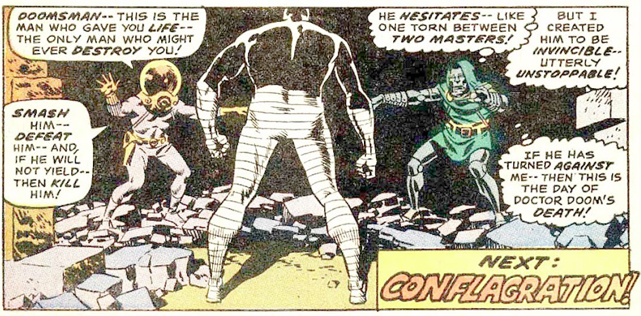 We'll find out - next time!
We'll find out - next time!
posted 21/9/2018 by MJ Hibbett
(click here for permanent link)
(0) comments
Unto You Is Born... The Doomsman!
A year after his tryout in Marvel Superheroes #20, Doom finally gets an ongoing series, albeit one shared with Ka-Zar, another Marvel Super-heroes alumni. However, even with only half an issue, Roy Thomas and Wally Wood pack in an awful lot of story, continuing the characterisation of Doom that Thomas began the previous year, as a tortured soul determined to succeed at being a ruthless dictator, whatever his heart might say.
The story begins with Buzz Aldrin and Neil Armstrong finding a strange globe on the moon which, when shown to Nixon on their return, turns out to be yet another remote broadcasting device belonging to Doctor Doom. As has been frequently mentioned, he does love to taunt people by television, and he's gone to an enormous amount of trouble to do it this time, teleporting a spherical screen a quarter of a million miles just to show how clever he is!
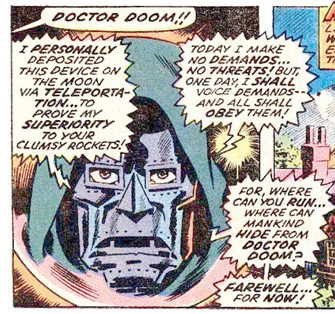 We then cut to Latveria, a "storybook kingdom" "nestled high in the bavarian alps" where the people scatter in fear as their dictator approaches, recreating once again the classic scene of Doom walking amongst his people, first seen back in Fantastic Four Annual #2 and repeated many times since.
We then cut to Latveria, a "storybook kingdom" "nestled high in the bavarian alps" where the people scatter in fear as their dictator approaches, recreating once again the classic scene of Doom walking amongst his people, first seen back in Fantastic Four Annual #2 and repeated many times since.
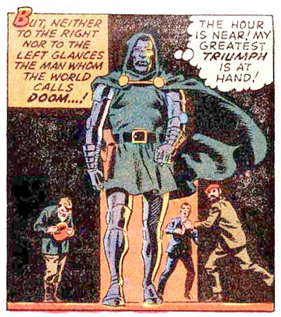
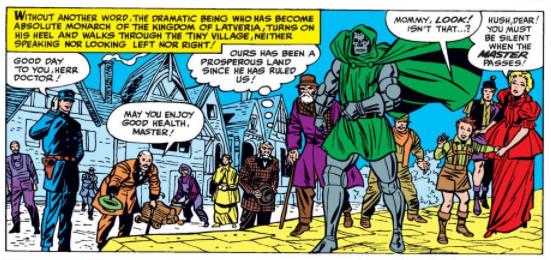 He's off to view his latest Mad Science project, unaware that the Latverian Resistance is plotting against him. Right from the start, the Latverian Resistance is shown to be a somewhat dubious organisation, who seem to be oddly fond of "hailing" people.
He's off to view his latest Mad Science project, unaware that the Latverian Resistance is plotting against him. Right from the start, the Latverian Resistance is shown to be a somewhat dubious organisation, who seem to be oddly fond of "hailing" people.
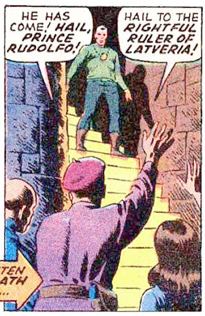 Their leader is Prince Rudolfo, technically the heir to the Latverian throne. He is, not to mince words, a bit of a dick, and some of the members of the resistance are uneasy about allying themselves with someone who makes no secret of the fact that all he cares about is putting himself back on the throne.
Their leader is Prince Rudolfo, technically the heir to the Latverian throne. He is, not to mince words, a bit of a dick, and some of the members of the resistance are uneasy about allying themselves with someone who makes no secret of the fact that all he cares about is putting himself back on the throne.
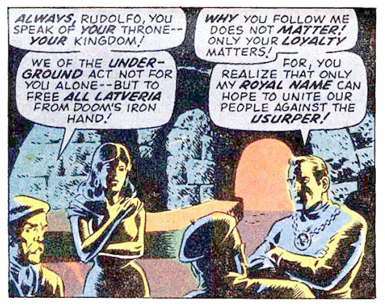 Rudolfo resembles Doom in many ways, but the key difference is that Rudolfo has done nothing to earn his rulership, whereas Doom at least led a revolution - something which could go either way in American readers' affections, depending on whether he's "good" revolutionary (like the Americans themselves) or a "bad" one like Lenin. Making Rudolfo resemble a Nazi is a way of nudging the readers' sympathies away from him. After all, it's Doom, not Rudolfo, who is the hero of this story, so traditionally storytelling would dictate that he's the one the readers should be sympathising with.
Rudolfo resembles Doom in many ways, but the key difference is that Rudolfo has done nothing to earn his rulership, whereas Doom at least led a revolution - something which could go either way in American readers' affections, depending on whether he's "good" revolutionary (like the Americans themselves) or a "bad" one like Lenin. Making Rudolfo resemble a Nazi is a way of nudging the readers' sympathies away from him. After all, it's Doom, not Rudolfo, who is the hero of this story, so traditionally storytelling would dictate that he's the one the readers should be sympathising with.
Similar, Rudolfo's Cunning Scheme to bring Doom down does not exactly endear him to readers. He has recruited a girl who resembles Doom's lost love Valeria (introduced in Thomas's previous issue) and he intends to use this resemblance to destroy his opponent. How Rudolfo knows about Valeria, or what she looks like, is not discussed.
Thus the girl, Ramona, is deposited in a faked car crash where she is seen by some of Doom's robots, who have instructions to bring anyone resembling Valeria to their master. The entire scheme falls apart instantly, and rather wonderfully, as Doom (who has extensive history with body swaps and doubles) immediately, and very sensibly, uses his Hypno Probe to see if the girl is who she appears to be, and quickly discovers that she is part of Rudolfo's plan to overthrow him. If only more superheroes and villains took the time to check things before flying into action there would be a lot fewer misunderstandings!
Interestingly, rather than thrash about with rage, screaming at subordinates, Doom wanders off to have a bit of a mope on the balcony, demonstrating that this is the sensitive version of Doom who we saw in Marvel Superheroes and his original origin story, rather than the deluded despot seen in recent issues of The Fantastic Four.
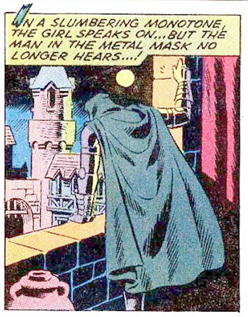 When he finds out that the plan has failed Rudolfo tells his men that this was all part of an even more Cunning Scheme to put Doom off his dictatorial stride (is he related to Reed Richards, I wonder?), much to the disgust of the resistance members, who quite rightly point out that risking their lives so easily makes him no better than Doom.
When he finds out that the plan has failed Rudolfo tells his men that this was all part of an even more Cunning Scheme to put Doom off his dictatorial stride (is he related to Reed Richards, I wonder?), much to the disgust of the resistance members, who quite rightly point out that risking their lives so easily makes him no better than Doom.
The Cunning Scheme does seems to be working, however, as an emotional Doom finds himself unmasking in front of Ramona/Valeria. Underneath the mask she sees not his true face, but an illusion he has set up of his previous handsome looks, leading her to say "Yours is a face - a woman could love!" This is all too much for the sensitive, self-aware Doom, who rushes from the room regretting his own weakness. "I cannot - will not live a lie!" he thinks, as he returns to the Mad Science dungeon which is, he believes, his only true home.
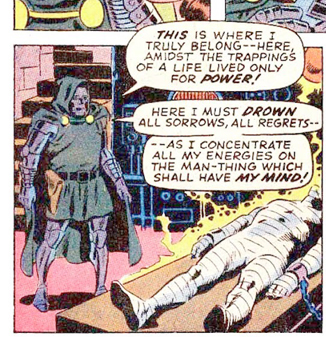 This is some beautiful characterisation by Thomas, aided by some lovely artwork by the great Wally Wood, who still manages to convey Doom's inner turmoil through body language, despite facial expressions being all but ruled out beneath a full face mask.
This is some beautiful characterisation by Thomas, aided by some lovely artwork by the great Wally Wood, who still manages to convey Doom's inner turmoil through body language, despite facial expressions being all but ruled out beneath a full face mask.
Doom decides to get on with his day job, which today involves placing his own brain patterns inside a robot. While he's busying himself with the mundanities of the nine to five Rudolfo (who doesn't get any subtle shades to his characterisation) launches his attack, sending Ramona into the lab where she catches Doom with his mask off and no illusions in place to conceal his true face. Appalled by what she sees, and the evidence of the Mad Science he's working on, she tries to smash up the lab, cutting power to the castle in the process and allowing the jetpack-wearing resistance to storm the barricades, unhindered of the robot guards who, apparently, were plugged into the same power supply which has now been cut off.
During all this the creature Doom was developing - the "Doomsman" - also manages to escape and flee the area, heading for the next issue.
It's all going well for Rudolfo until Doom himself enters the fray, using technical wizardry to confuse the interlopers with multiple mirages of himself. When they finally work out which one is the "real" Doom he explodes, and they discover that it was a robot all along, primed with explosive. The real Doom, as is his wont in whatever characterisation, is watching, and gloating, from the safety of his castle. He does this while sitting in the same broadcasting booth that was seen in Fantastic Four #85, demonstrating that Wood is attempting to work with the visual continuity established by Jack Kirby, even while Thomas is diverging from the characterisation being pursued by Stan Lee.
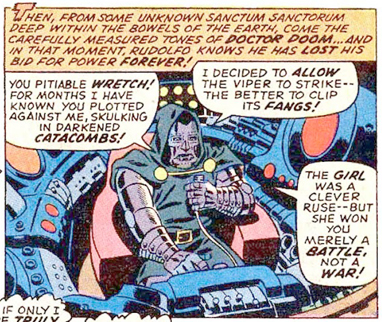 The story ends with Doom celebrating victory over his enemies while still harbouring personal doubts. The Doomsman is still at large, with a copy of his own brain inside a super-robot body, meaning that "I may have created the most formidable enemy of all!" He may be sensitive, but he's still Doom and still arrogant - whether he's right, however, we'll find out next time!
The story ends with Doom celebrating victory over his enemies while still harbouring personal doubts. The Doomsman is still at large, with a copy of his own brain inside a super-robot body, meaning that "I may have created the most formidable enemy of all!" He may be sensitive, but he's still Doom and still arrogant - whether he's right, however, we'll find out next time!
posted 14/9/2018 by MJ Hibbett
(click here for permanent link)
(0) comments
Doom In Advertising
Doctor Doom does not appear in this comic at all, which is a shame as it's drawn by Gil Kane and looks gorgeous. The reason it's found its way into my database is that the entry on The Grand Comics Database lists Doom as appearing in an advert for Astonishing Tales #1.
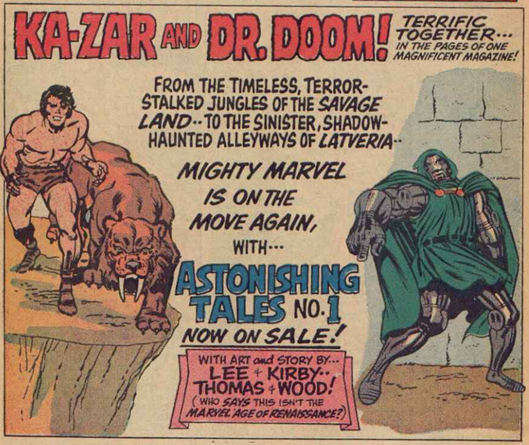 This is part of the problem with using data submitted by lots of different people at different times without clear guidance on exactly what they should be including. Other adverts appear that don't get included, while some adverts that do don't list every character, so it's impossible to get a clear view on what's happening across the full range of comics published.
This is part of the problem with using data submitted by lots of different people at different times without clear guidance on exactly what they should be including. Other adverts appear that don't get included, while some adverts that do don't list every character, so it's impossible to get a clear view on what's happening across the full range of comics published.
It also forces me to go beyonad Marvel Unlimited in search of explanation - it's a great site, but it only tends to include story pages, rather than the adverts and other editorial material, so in this case I had to find scanned copies elsewhere, which actually turned out to be very handy as it also showed me this advertisement:
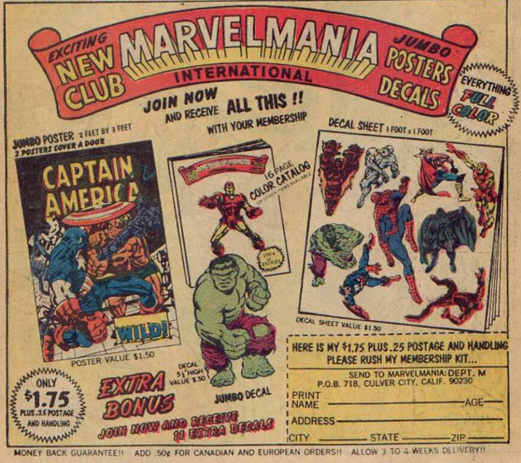 This was NOT listed on GCD, showing once again how haphazard the listings are. I'm very glad to have found it though, as Doctor Doom is one of the characters on the decal stickers sheet, and once again he's the only villain amongst Marvel's most popular heroes. This is something I'll be covering elsewhere, outside of this blog, when I look at the "non-narrative" appearances of Doom, but it's a great find. Thanks, non-standardised data enterers!
This was NOT listed on GCD, showing once again how haphazard the listings are. I'm very glad to have found it though, as Doctor Doom is one of the characters on the decal stickers sheet, and once again he's the only villain amongst Marvel's most popular heroes. This is something I'll be covering elsewhere, outside of this blog, when I look at the "non-narrative" appearances of Doom, but it's a great find. Thanks, non-standardised data enterers!
posted 10/9/2018 by MJ Hibbett
(click here for permanent link)
(0) comments
The Long Journey Home
This comic is a landmark 100th issue (not including annuals) of an uninterrupted run from two of the absolute greats of comics, promising every single villain ever. And it's a big disappointment. Doom's on the front cover, right in the centre, fighting Mr Fantastic, but he only appears very briefly in the issue itself, and even then it's not the "real" Doctor Doom.
I know that this is almost the end of that run, when Jack Kirby was fed up with the way he was being treated and was clearly no longer pouring his all into the artwork, but coming only a year or so after "The Power And The Pride!" it all looks very mundane, and the story itself is a big let down.
The plot, such that it is, sees The Fantastic Four (and Crystal) attacked on their way home from a mission. They crash land and are attacked by Kang The Conqueror and a particularly pedantic Doctor (not "Doc") Doom.
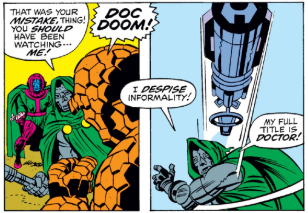 There's just time for Doom to bring up the whole "Are Doom and Kang and Rama-Tut the same person?" nonsense (I wish he wouldn't, it makes precisely NO sense) before Crystal zaps a tree and, basically, kills them both.
There's just time for Doom to bring up the whole "Are Doom and Kang and Rama-Tut the same person?" nonsense (I wish he wouldn't, it makes precisely NO sense) before Crystal zaps a tree and, basically, kills them both.
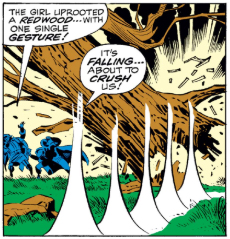 Luckily for all concerned it turns out that Crystal isn't a murderer, as these were just androids, created by The Mad Thinker and The Puppet Master. They have loads of these androids, which apparently have "the powers and the memories" of the originals, but still AREN'T the originals, which makes the whole thing feel a bit of a let down. It's the 100th issue and the Fantastic Four are fighting The Mad Thinker and The Puppet Master, not exactly the Premier League of their bad guys.
Luckily for all concerned it turns out that Crystal isn't a murderer, as these were just androids, created by The Mad Thinker and The Puppet Master. They have loads of these androids, which apparently have "the powers and the memories" of the originals, but still AREN'T the originals, which makes the whole thing feel a bit of a let down. It's the 100th issue and the Fantastic Four are fighting The Mad Thinker and The Puppet Master, not exactly the Premier League of their bad guys.
Their plans to conquer the FF collapse when they unleash an android version of The Hulk, who refuses to obey orders and instead sets about destroying the lab. The Puppet Master tries to shoot him and accidentally hits some explosives, blowing them all up. Thus, not only do the FF not fight most of their baddies, they don't even win!
It all ends with the team hitching a ride on "a specially requisitioned NATO plane", and congratulating themselves on the face that they're still together.
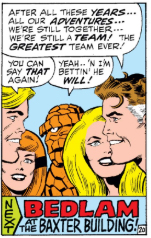 This is surely Stan Lee talking to Jack Kirby, but it rings very hollow indeed. They're far from at their best, and they won't be together much longer, with Kirby leaving after issue 102. It is, as stated earlier, a disappointing way to wind up one of the greatest runs of superhero comics... EVER!
This is surely Stan Lee talking to Jack Kirby, but it rings very hollow indeed. They're far from at their best, and they won't be together much longer, with Kirby leaving after issue 102. It is, as stated earlier, a disappointing way to wind up one of the greatest runs of superhero comics... EVER!
posted 7/9/2018 by MJ Hibbett
(click here for permanent link)
(0) comments
In The Darkness Dwells... Doom!
It's another issue drawn by John Buscema for us today as he fills in for the regular series artist, the great, sadly departed Marie Severin who was, according to the credits box, "vacationing in the beautiful Bahamas!"
It's a great looking story, packed with Buscema's dynamic art, packed with straining figures as a de-powered Namor struggles to escape from the US Army.
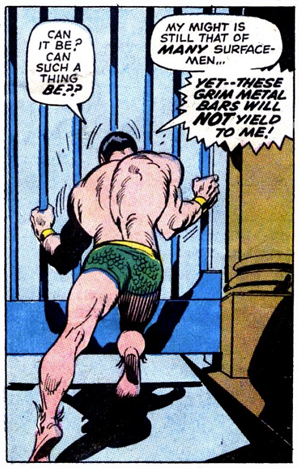 Eventually he finds his way to the back of a building which, as luck or otherwise would have it, turns out to be the Latverian Embassy. What are the chances? Namor is allowed in, and he's saved from the army, only to be attacked by what appears to be a lazer-powered vacuum cleaner.
Eventually he finds his way to the back of a building which, as luck or otherwise would have it, turns out to be the Latverian Embassy. What are the chances? Namor is allowed in, and he's saved from the army, only to be attacked by what appears to be a lazer-powered vacuum cleaner.
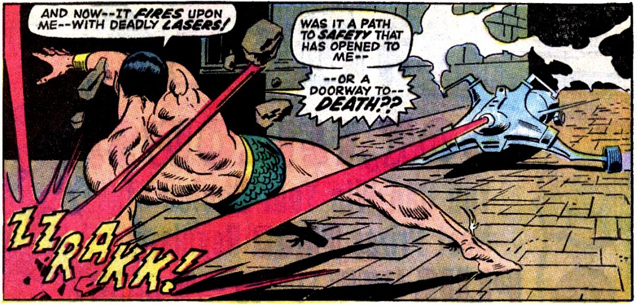 It's all part of the security system operated by Doctor Doom, who quickly shows up calling himself Namor's friend. The Sub-mariner quite rightly points out that the last time they met Doom betrayed him, and Doom dismisses this as an "old mistake" which should not get in the way of their common goals.
It's all part of the security system operated by Doctor Doom, who quickly shows up calling himself Namor's friend. The Sub-mariner quite rightly points out that the last time they met Doom betrayed him, and Doom dismisses this as an "old mistake" which should not get in the way of their common goals.
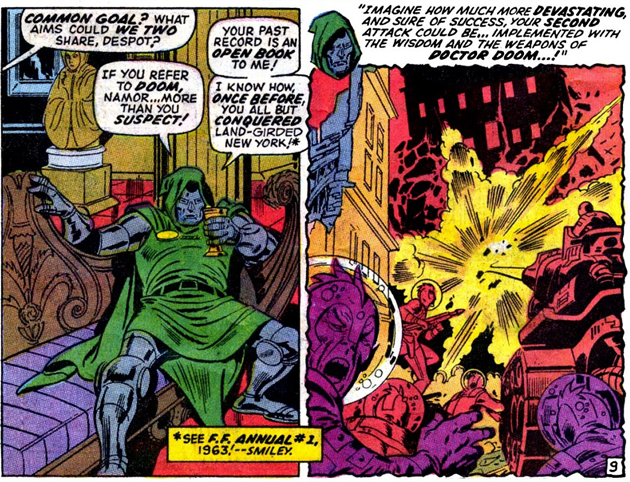 This is the same Doom who, very recently trapped Diablo in a post-apocalyptic nightmare future for daring to propose an alliance, in a story also written by Roy Thomas, yet here is talking team-ups, it seems, with anybody who happens to pop round the back door. Perhaps he sees Namor as more of an equal - he does also rule his own kingdom, as he points out, which could "swallow Latveria whole."
This is the same Doom who, very recently trapped Diablo in a post-apocalyptic nightmare future for daring to propose an alliance, in a story also written by Roy Thomas, yet here is talking team-ups, it seems, with anybody who happens to pop round the back door. Perhaps he sees Namor as more of an equal - he does also rule his own kingdom, as he points out, which could "swallow Latveria whole."
In general, however, Doom's characterisation here tends to match the one which appeared in the recent Marvel Super-Heroes appearance, rather than that seen over in The Fantastic Four, with Doom using his own wits and technology rather than the power of the state. Maybe he just behaves differently at home to how he does when he's in the embassy?
Actually, maybe he does? Let's keep an eye on that in future!
Namor refuses the offer of an alliance, which Doom accepts with apparent ease. All the Sub-Mariner wants is a glass of water to restore his strength, so Doom promises to pop off and get him one. However, instead of heading to the kitchen sink, Doom gathers a few henchmen together to tell them his cunning plan - to lock Namor in the embassy and remove all traces of water from the building!
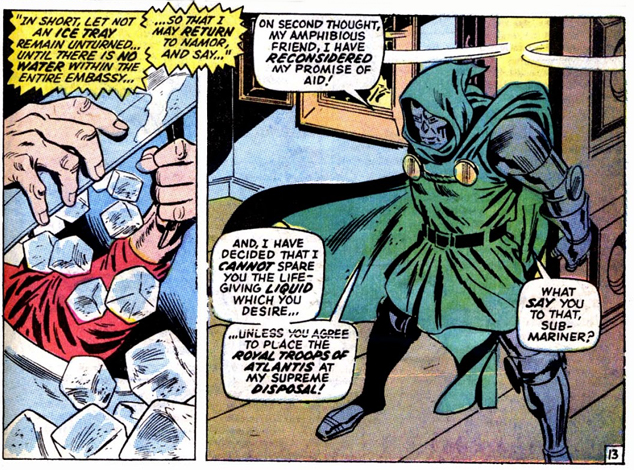 What a fiend! It's noticeable that the Embassy staff are very different from his servants in Latveria, looking more like hired mercenaries rather than Latverian peasants, although the ambassador does at least try to discuss diplomatic niceties with his boss.
What a fiend! It's noticeable that the Embassy staff are very different from his servants in Latveria, looking more like hired mercenaries rather than Latverian peasants, although the ambassador does at least try to discuss diplomatic niceties with his boss.
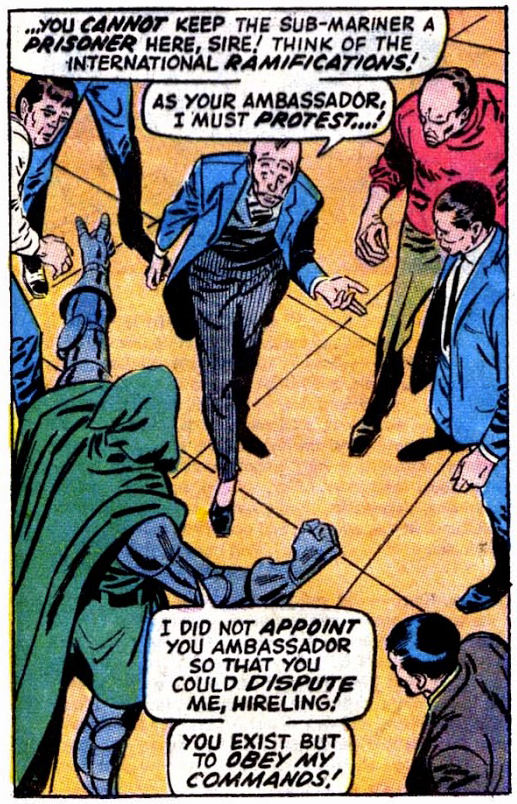 If Jeff Sessions ever read this comic, I wonder if he'd sympathise? Doom tells Namor what's going on, and the Sub-Mariner fights back. Last time there was a scrap in the Embassy Doom duffed up Daredevil easily, but here the de-powered Namor is a much trickier opponent, forcing Doom to call in his "army of mercenaries" to bring him down.
If Jeff Sessions ever read this comic, I wonder if he'd sympathise? Doom tells Namor what's going on, and the Sub-Mariner fights back. Last time there was a scrap in the Embassy Doom duffed up Daredevil easily, but here the de-powered Namor is a much trickier opponent, forcing Doom to call in his "army of mercenaries" to bring him down.
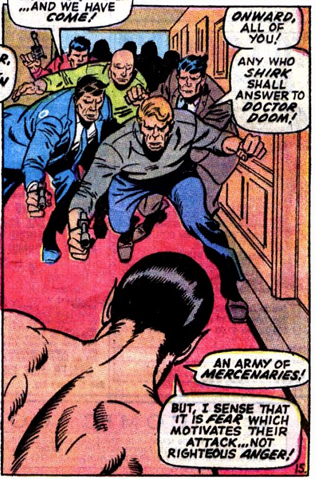 Again, this is a return to earlier versions of Doom without armies of killer robots, but maybe this really is what happens when he's in America. I guess there isn't a diplomatic bag big enough to bring his Robot Factories over, so he has to rely on hired human help instead.
Again, this is a return to earlier versions of Doom without armies of killer robots, but maybe this really is what happens when he's in America. I guess there isn't a diplomatic bag big enough to bring his Robot Factories over, so he has to rely on hired human help instead.
The mercenaries aren't up to much, and eventually Doom realises that he has to step in himself, going head to head with his former ally and unleashing Heat Rays which drain Namor of moisture and, basically, start to burn him to death. Namor pretends to be defeated, but in one last act of defiance manages to break one of the Heat Ray Guns, unleashing "pent-up flames" on the building.
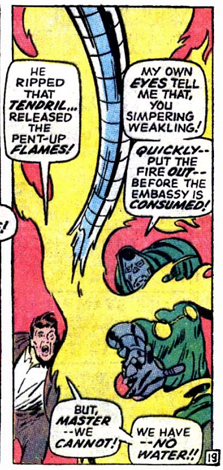 As the lackey says, this is a bit of a problem because they don't have any water in the building to use to put it out. I'm not au fait with 1960s US Fire Regulations in Diplomatic Buildings, but surely they would have had some capacity for dealing with such a threat? Like a fire extinguish, or even just turning off the Heat Rays?
As the lackey says, this is a bit of a problem because they don't have any water in the building to use to put it out. I'm not au fait with 1960s US Fire Regulations in Diplomatic Buildings, but surely they would have had some capacity for dealing with such a threat? Like a fire extinguish, or even just turning off the Heat Rays?
Luckily for all concerned the New York Fire Brigade turns up, blasting water into the building which not only puts out the fire but douses Namor in water, allowing him to regain his strength and flee. Doom is unable to stop him because, he says, doing so would violate his Diplomatic Immunity.
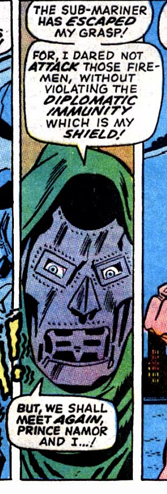 Yet again Doom (or, rather, Roy Thomas) seems to contradict himself. Back in Marvel Super-Heroes Doom specifically said that he didn't care about Diplomatic Immunity, yet here he is saying that he's prepared to let an adversary escape, rather than risk losing it. I'd argue that the truth of this is that Doom really does care about his immunity, and he was just getting over-excited and showing off in front of Diablo before.
Yet again Doom (or, rather, Roy Thomas) seems to contradict himself. Back in Marvel Super-Heroes Doom specifically said that he didn't care about Diplomatic Immunity, yet here he is saying that he's prepared to let an adversary escape, rather than risk losing it. I'd argue that the truth of this is that Doom really does care about his immunity, and he was just getting over-excited and showing off in front of Diablo before.
So the story ends with Doom's character appearing to vary according to where he is. This version of him seems to be a continuation of his appearances in Daredevil and, going further back, The Peril And The Power!, where he's willing to get directly involved in conflict, rather than the version we've just seen in The Power And The Pride! who prefers to operate from afar. The clear similarity between the latter two story titles now makes me wonder if the change into a deluded despot was a deliberate attempt by Lee and/or Kirby to evolve the character into something new, possibly as a commentary on current events in Eastern Europe, with Roy Thomas and others instead building on the quasi-heroic character first introduced back in Fantastic Four Annual #2. Or maybe we can explain it in-universe by saying that Doom, like so many of us, just acts differently at work to how he does at home?
Either way, it's a fascinating development for the character, which hopefully we'll be seeing more of soon as we approach his first appearances as an ongoing (shared) lead in Astonishing Tales!
posted 5/9/2018 by MJ Hibbett
(click here for permanent link)
(0) comments
The Space Spanner Returns
There's just a single cameo appearance by Doctor Doom in this issue, but it's one that draws into question the intelligence of The Silver Surfer, for LO! he has been called a spanner of space before, and he definitely acts like a right spanner here.
The story starts off with a Dr Frankenstein and his hunchbacked assistant doing various experiments which lead to them being attacked by a village mob. Throughout the story this Frankenstein talks about his ancestors, and the villagers shout about wanting to be rid of Frankensteins in the plural, which means that there must have been at least two more before him, who also created monsters. How this all worked, and how the family managed to maintain a castle in the same village despite all the monster creation, is not explained. Instead we see the current holder of the name sitting at home watching videos of one of his predecessors, which look suspiciously like certain old movies...
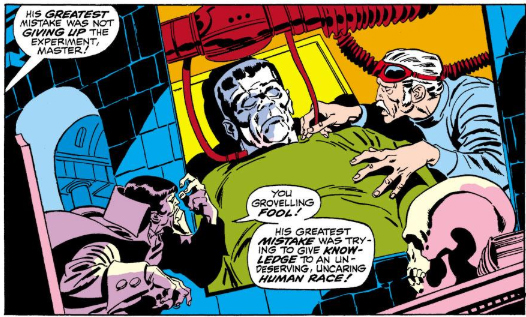 The Silver Surfer eventually comes into the story when he notices the angry mob heading for Frankenstein's castle. "Once again I must bear witness to man's inhumanity to man!" he sighs, like an Intergalactic Morrissey, then zooms down to disperse the mob. He then flies into the castle to meet the man he's just saved, and remarks that the last time he did this it was to meet Doctor Doom.
The Silver Surfer eventually comes into the story when he notices the angry mob heading for Frankenstein's castle. "Once again I must bear witness to man's inhumanity to man!" he sighs, like an Intergalactic Morrissey, then zooms down to disperse the mob. He then flies into the castle to meet the man he's just saved, and remarks that the last time he did this it was to meet Doctor Doom.
 "I gave him my trust... and lived to regret it," says Moz... sorry, the Silver Surfer, who then goes on to make EXACTLY the same mistake again. Maybe on Zenn-La things like cloaks, histrionic protestations of innocence, eeries castles and evil henchmen are associated with delightful toddlers and fluffy kittens? It's the only explanation for what a total pillock he is here.
"I gave him my trust... and lived to regret it," says Moz... sorry, the Silver Surfer, who then goes on to make EXACTLY the same mistake again. Maybe on Zenn-La things like cloaks, histrionic protestations of innocence, eeries castles and evil henchmen are associated with delightful toddlers and fluffy kittens? It's the only explanation for what a total pillock he is here.
He allows Frankenstein (who is called FRANKENSTEIN for heaven's sake) to conduct an experiment on him, which creates an Evil Duplicate, which leads to a massive battle than involves the Air Force being called out, and ends with the Surfer beating his rival because he can concentrate for slightly longer. The story ends with a, to me, hilarious picture showing the Surfer lying on his bed... sorry, an asteroid, moping like a massive teenager about how misunderstood and sensitive he is.
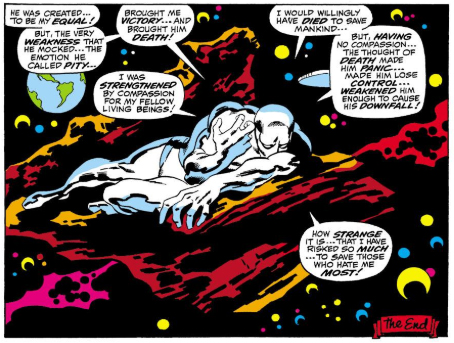 It's one of Stan Lee's daftest scripts, but it looks gorgeous throughout, with Sal Buscema providing thrilling inks for his big brother John's wonderful pencils. They even make a rabid rabbit looking exciting!
It's one of Stan Lee's daftest scripts, but it looks gorgeous throughout, with Sal Buscema providing thrilling inks for his big brother John's wonderful pencils. They even make a rabid rabbit looking exciting!
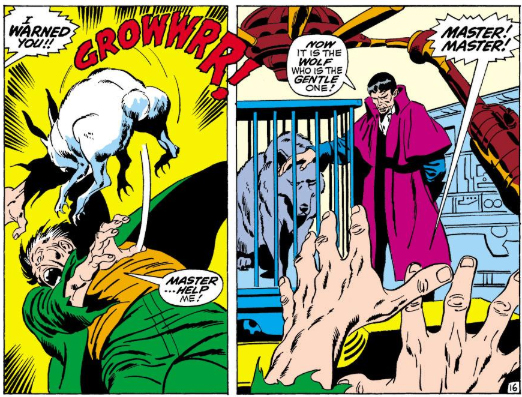 Next time there's more John Buscema as Doom meets, and fights, Namor The Submariner once again, in a story that is a big step towards Doom's 70s characterisation and position as an occasional lead character.
Next time there's more John Buscema as Doom meets, and fights, Namor The Submariner once again, in a story that is a big step towards Doom's 70s characterisation and position as an occasional lead character.
posted 3/9/2018 by MJ Hibbett
(click here for permanent link)
(0) comments